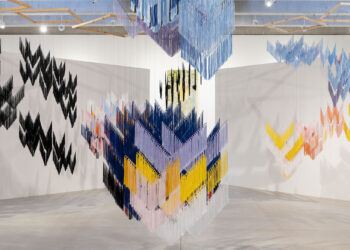The exhibition will be on view at Hirshhorn in fall 2023 and in a joint presentation at LACMA and CAAM in summer 2024. The exhibition is accompanied by the first monograph of Leigh’s work.

Simone Leigh, Martinique, 2022. Glazed stoneware, 154.3 x 104.8 x 101cm. Courtesy the artist and Matthew Marks Gallery. Photo by Timothy Schenck. © Simone Leigh
The Institute of Contemporary Art/Boston (ICA) welcomes home Simone Leigh’s work created for the Venice Biennale, kicking off a national tour that begins at the ICA on April 6 and runs through September 4, 2023. Leigh represented the United States at the 59th International Art Exhibition of La Biennale di Venezia, in a project commissioned by the ICA. More than 35 works will be presented in Simone Leigh, including 10 works exhibited at the U.S. Pavilion. The exhibition also features key early works that speak to the artist’s consistent interest in the forms and materials of Black feminist thought, and recent ceramics, bronzes, and videos.
Following its debut at the ICA, the exhibition will then move to the Hirshhorn Museum and Sculpture Garden in Washington, D.C. from November 2023 through March 2024. The tour will conclude in a joint presentation at the Los Angeles County Museum of Art (LACMA) and California African American Museum (CAAM), on view June 2024 through January 2025 in Los Angeles. Simone Leigh is organised by Eva Respini, ICA Deputy Director for Curatorial Affairs and Barbara Lee Chief Curator, with Anni A. Pullagura, Curatorial Assistant.
“Simone Leigh’s complex and profoundly moving work honours the agency and ideas of Black women, giving visibility to overlooked narratives and histories,” said Jill Medvedow, Ellen Matilda Poss Director of the ICA. “We are thrilled to bring Simone Leigh’s art from Venice back to the U.S. as part of this landmark exhibition, so that audiences across the country have the opportunity to experience the work of this consequential and influential artist.”
“It is with pleasure that we expand this presentation to go beyond the works from Venice, including many recent works on view for the first time,” said Eva Respini, who was the Co-Commissioner of the U.S. Pavilion and Curator of the exhibition. “This exhibition reveals and celebrates an artist working at the height of her artistic powers.”
Featuring interrelated sculptures in ceramic, bronze, and raffia, the first galleries of the exhibition will display recent and new works made largely within the past five years. The exhibition culminates with Leigh’s historic Venice exhibition, presented at the ICA in a sequence that evokes the layout of the U.S. Pavilion, providing American audiences the opportunity to experience this historic installation. The exhibition concludes with Last Garment (2022), a bronze based on a 19th-century souvenir photograph of a Jamaican laundress that explores histories of labor, specifically the anonymous labor of Black women. The ICA presentation will feature a new, larger reflecting pool for Last Garment, breathtakingly situated with a sightline of Boston Harbor.
One of the most important artists working today, Leigh creates sculpture, video, installation, and social practice works that situate questions of Black femme, or female-identified, subjectivity at the center of contemporary art discourse. Leigh’s art addresses a wide swath of historical periods, geographies, and traditions, with specific references to vernacular and hand-made processes from across the African diaspora, as well as forms traditionally associated with African art and ritual, all while mining historical gaps, inaccuracies, and fallacies in material and visual culture. Saidiya Hartman’s conception of “critical fabulation” – a strategy that invites historians, artists, and critics to creatively fill the gaps of history – provides a resonant framework for approaching Leigh’s work.
The exhibition features works at both intimate and large scale. A selection of Leigh’s table-top ceramic busts point to her fluency in the medium of ceramics, including references to the Black American folk art tradition of stoneware face vessels; these citations are also rehearsed in larger ceramic works, which draw on the vernacular traditions of the American South, Caribbean, and African continent, and challenge traditional hierarchies of art and labor. Domestic vessels such as bowls and jugs, cowrie shells, and busts are recurring motifs, and her readdress of these forms over time and in various materials underscores the remarkable consistency of Leigh’s vision.
In recent large-scale ceramic sculptures, Leigh merges the human body with traditional domestic containers, conjuring black woman’s labor and knowledge production. The intersection of architecture with the body is also central to her sculpture, such as the work Cupboard IX (2019), seen in the steel cage-like structures that the artist leaves bare or covered with raffia, evoking the womb, skirts, and sub-Saharan dwellings, often built by women and used as gathering spaces.
In 2018, the artist began casting her sculptural works in bronze, creating statuary for both gallery presentations and public art commissions. Her bronzes combine figuration with domestic or architectural elements, such as in the 2019 sculpture Jug, featuring the head and torso of a woman’s body atop a large-scale vessel. Through their material choices, these bronzes embody a state of permanence and grandeur; with their overtly Black feminist and aesthetic references, Leigh’s bronzes also insist on the centrality – indeed, the necessity – of considering the agency of Black women as subjects in the cultural sphere. The exhibition will feature Leigh’s monumental 24-foot-tall bronze Satellite (2022), sited at the entrance of the ICA, broadcasting ideas around self-determination that are endemic to the work.
Leigh’s videos, often created in collaboration with other artists, draw from historical and fictional representations of Black women and femmes. Conspiracy (2022), made with filmmaker Madeleine Hunt-Ehrlich, focuses on the performativity of making and the studio as a site of labor and care. In the video my dreams, my works, must wait till after hell (2011), Leigh and artist Chitra Ganesh reimagine the reclining female nude, a common subject in European art. Another 2011 collaboration between Leigh and artist Liz Magic Laser, titled Breakdown, features mezzo-soprano Alicia Hall Moran singing a script the two artists compiled from fictional scenes of individuals experiencing nervous breakdowns, offering a stunning meditation on psychology, race, and gender.
For more information, please visit Institute of Contemporary Art/Boston.



